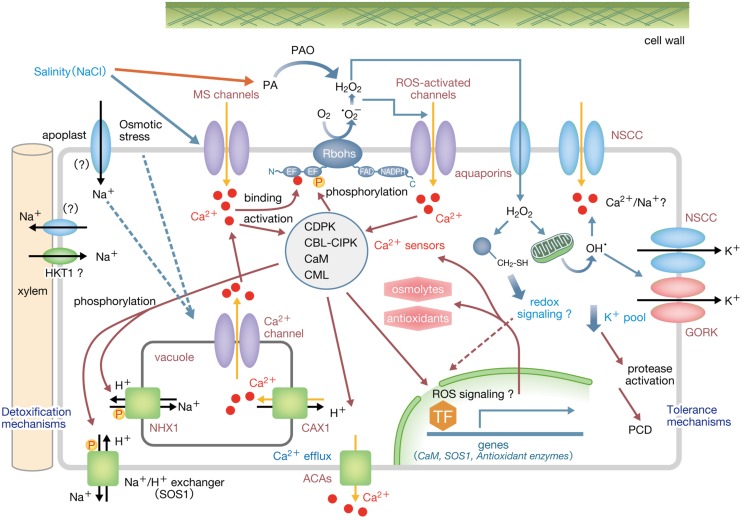FIGURE 1.
A possible Ca2+-ROS signaling network involved in osmotic responses under salinity stress in root cells. Salinity stress causes osmotic shock to trigger the activation of PM MS Ca2+-permeable channels and Ca2+ influx. Elevated [Ca2+]cyt leads to activation of various Ca2+ sensor proteins including CaMs, CMLs, CBLs, CDPKs as well as the ROS-producing enzyme, Noxs/Rbohs that are synergistically activated by Ca2+ binding and phosphorylation by Ca2+-dependent protein kinases such as CDPKs and CBL–CIPK complexes. Elevated apoplastic ROS activates ROS-activated PM Ca2+-permeable channels to trigger further Ca2+ influx, while Ca2+-permeable endomembrane channels/transporters may also been activated to sustain further Ca2+ mobilization. Elevated [Ca2+]cyt may trigger downstream events such as activation of SOS1 and NHX1, Na+/H+ exchangers that transport cytosolic Na+, regulation of xylem loading of Na+, induction of osmolytes and osmo-protective proteins, and the retention of cytosolic ion balance. Ca2+-dependent protein kinases activated by elevated [Ca2+]cyt mediate downstream events including expression of genes encoding proteins such as SOS1, antioxidant enzymes, osmolytes-biosynthetic enzymes as well as CaMs as signal amplifiers. Elevated [Ca2+]cyt is reverted by the orchestrated action of active transporters such as Ca2+ exchangers and Ca2+-ATPases at the PM and tonoplast. H2O2 is transported to the cytosol by PM aquaporins to modify the cysteine residues of target proteins, thereby promoting redox signaling to regulate gene expression. Broken arrows indicate hypothetical links. ACA, autoinhibited Ca2+-ATPase; PA, polyamine; PAO, polyamine oxidase.

